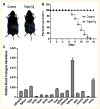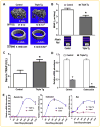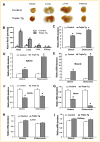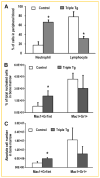Inducible expression of Runx2 results in multiorgan abnormalities in mice
- PMID: 21268087
- PMCID: PMC5079519
- DOI: 10.1002/jcb.22968
Inducible expression of Runx2 results in multiorgan abnormalities in mice
Abstract
Runx2 is a transcription factor controlling skeletal development, and is also expressed in extraskeletal tissues where its function is not well understood. Existing Runx2 mutant and transgenic mouse models do not allow the necessary control of Runx2 expression to understand its functions in different tissues. We generated conditional, doxycyline-inducible, triple transgenic mice (CMV-Cre;ROSA26-neo(flox/+)-rtTA;Tet-O-Runx2) to investigate the effects of wide spread overexpression of Runx2. Osteoblasts isolated from CMV-Cre;ROSA26-neo(flox/+)-rtTA; Tet-O-Runx2 mice demonstrated a dose-dependent effect of doxycycline to stimulate Runx2 transgene expression. Doxycycline administration to CMV-Cre;ROSA26-neo(flox/+)-rtTA;Tet-O-Runx2 mice induced Runx2 transgene expression in all tissues tested, with the highest levels observed in kidney, ovary, and bone. Runx2 overexpression resulted in deceased body size and reduced viability. With regard to bone, Runx2 overexpressing mice paradoxically displayed profound osteopenia and diminished osteogenesis. Induced expression of Runx2 in extraskeletal tissues resulted in ectopic calcification and induction of the osteogenic program in a limited number of tissues, including lung and muscle. In addition, the triple transgenic mice showed evidence of a myeloproliferative disorder and an apparent inhibition of lymphocyte development. Thus, overexpression of Runx2 both within and outside of the skeleton can have diverse biological effects. Use of tissue specific Cre mice will allow this model to be used to conditionally and inducibly overexpress Runx2 in different tissues and provide a means to study the post-natal tissue- and cell context-dependent functions of Runx2.
Copyright © 2010 Wiley-Liss, Inc.
Figures








Similar articles
-
An analysis of skeletal development in osteoblast-specific and chondrocyte-specific runt-related transcription factor-2 (Runx2) knockout mice.J Bone Miner Res. 2013 Oct;28(10):2064-9. doi: 10.1002/jbmr.1945. J Bone Miner Res. 2013. PMID: 23553905
-
Over expression of FGF7 enhances cell proliferation but fails to cause pathology in corneal epithelium of Kerapr-rtTA/FGF7 bitransgenic mice.Mol Vis. 2005 Mar 16;11:201-7. Mol Vis. 2005. PMID: 15788998
-
MicroRNA-29a mitigates glucocorticoid induction of bone loss and fatty marrow by rescuing Runx2 acetylation.Bone. 2015 Dec;81:80-88. doi: 10.1016/j.bone.2015.06.022. Epub 2015 Jul 2. Bone. 2015. PMID: 26141838
-
A Runx2 threshold for the cleidocranial dysplasia phenotype.Hum Mol Genet. 2009 Feb 1;18(3):556-68. doi: 10.1093/hmg/ddn383. Epub 2008 Nov 20. Hum Mol Genet. 2009. PMID: 19028669 Free PMC article.
-
Nell-1, a key functional mediator of Runx2, partially rescues calvarial defects in Runx2(+/-) mice.J Bone Miner Res. 2011 Apr;26(4):777-91. doi: 10.1002/jbmr.267. J Bone Miner Res. 2011. PMID: 20939017 Free PMC article.
Cited by
-
The RUNX family in breast cancer: relationships with estrogen signaling.Oncogene. 2013 Apr 25;32(17):2121-30. doi: 10.1038/onc.2012.328. Epub 2012 Oct 8. Oncogene. 2013. PMID: 23045283 Free PMC article. Review.
-
The role of microRNAs in bone remodeling.Int J Oral Sci. 2015 Sep 14;7(3):131-43. doi: 10.1038/ijos.2015.22. Int J Oral Sci. 2015. PMID: 26208037 Free PMC article. Review.
-
Osteogenic Programming of Human Mesenchymal Stem Cells with Highly Efficient Intracellular Delivery of RUNX2.Stem Cells Transl Med. 2017 Dec;6(12):2146-2159. doi: 10.1002/sctm.17-0137. Epub 2017 Oct 31. Stem Cells Transl Med. 2017. PMID: 29090533 Free PMC article.
-
Detection of RUNX2 gene expression in cumulus cells in women undergoing controlled ovarian stimulation.Reprod Biol Endocrinol. 2012 Nov 28;10:99. doi: 10.1186/1477-7827-10-99. Reprod Biol Endocrinol. 2012. PMID: 23186169 Free PMC article.
-
Estrogens antagonize RUNX2-mediated osteoblast-driven osteoclastogenesis through regulating RANKL membrane association.Bone. 2015 Jun;75:96-104. doi: 10.1016/j.bone.2015.02.007. Epub 2015 Feb 17. Bone. 2015. PMID: 25701138 Free PMC article.
References
-
- Ahn MY, Bae SC, Maruyama M, Ito Y. Comparison of the human genomic structure of the Runt domain-encoding PEBP2/CBFalpha gene family. Gene. 1996;168:279–280. - PubMed
-
- Banerjee C, Javed A, Choi JY, Green J, Rosen V, van Wijnen AJ, Stein JL, Lian JB, Stein GS. Differential regulation of the two principal Runx2/Cbfa1 n-terminal isoforms in response to bone morphogenetic protein-2 during development of the osteoblast phenotype. Endocrinology. 2001;142:4026–4039. - PubMed
-
- Bendayan D, Barziv Y, Kramer MR. Pulmonary calcifications: A review. Respir Med. 2000;94:190–193. - PubMed
-
- Blyth K, Terry A, Mackay N, Vaillant F, Bell M, Cameron ER, Neil JC, Stewart M. Runx2: A novel oncogenic effector revealed by in vivo complementation and retroviral tagging. Oncogene. 2001;20:295–302. - PubMed
Publication types
MeSH terms
Substances
Grants and funding
LinkOut - more resources
Full Text Sources
Molecular Biology Databases

